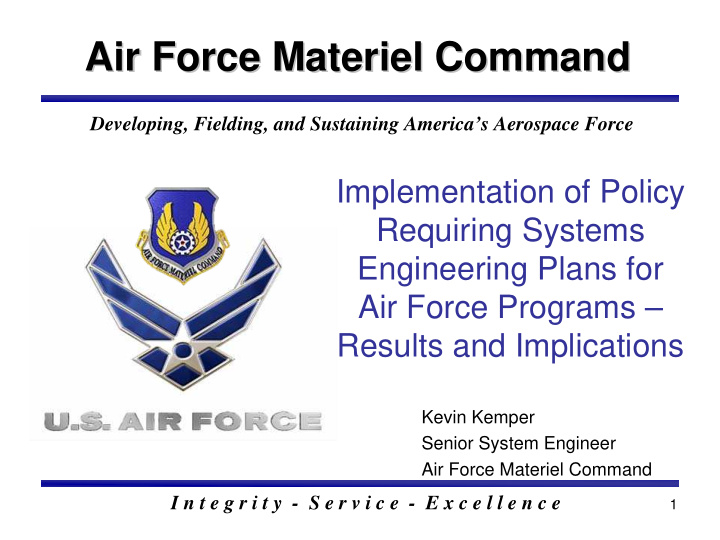



Air Force Materiel Command Air Force Materiel Command Developing, Fielding, and Sustaining America’s Aerospace Force Implementation of Policy Requiring Systems Engineering Plans for Air Force Programs – Results and Implications Kevin Kemper Senior System Engineer Air Force Materiel Command I n t e g r i t y - S e r v i c e - E x c e l l e n c e 1
Objective • Summarize and assess results of SEP reviews to date – SEP represents what is, not what should be – A measure of how well the revitalization of SE is going State of the Practice vs State of the Art 2
Overview • Background – policy, programs, reviewers • Review results • Implications • Recommendations 3
SE Implementation Hierarchy Systems/SoS Level Optimization Enterprise SE Integrated SE Processes SE Processes Single Engineering Authority Apologies to Maslow 4
5 Policy • Policy Memo • Draft AFI – Feb 04
About the Programs • Non-Space AF programs at a milestone – Small # of programs • Numerous other programs – Starting SEPs – Asking questions – Quick reviews 6
Air Force Reviewers • SAF/ACE and AQR • Extended Staff – AFMC/EN – AF Center for Systems Engineering 7
Areas Studied • Requirements definition • Processes • Risk • Key Performance Parameters • Enterprise SE • Multiple Reviews • Authorship • SEP Size 8
Requirement Definition –60% of programs adequately defined their requirements below the ICD/CDD –Many programs can point to a “textbook” requirements analysis/decomposition process –Fewer can point to a configuration controlled specification Quotes “We don’t have any requirements” 9
Processes • 27% of programs described processes • The rest either – Don’t have a process – Don’t know the process Process 101 If you can’t document the process You don’t have one 10
Risk • 55% of programs defined their risks • The rest – Simply don’t know what the risks are – Not a integral part of the program Quotes “I can’t list my risks in the SEP. They change daily” “Why do you need to know what the program risks are to do SE planning” 11
Key Performance Parameters • 73% of the programs list KPPs – KPPs are clearly stated as a SEP requirement Quotes “What have KPPs got to do with SE?” “I can’t list all of my program’s KPPs in the SEP. We have hundreds” “I don’t have any KPPs” 12
Scheduled Design Reviews • 55% of programs have entry and exit criteria for design reviews Quotes “ We are not there yet” 13
Integrated SE Processes • 10-20% of programs have fully integrated SE processes – Risk – Design reviews – Configuration Management 14
Multiple reviews • Few programs approved without multiple iterations • Approvals with comments 15
Authorship • SEPs written by – Prime contractor – Task order contractor – Reserve Officer – Junior members of program 16
Big SEPs • Don’t know what “they” want • Don’t know what my program is doing • Give “them” lots of stuff and hope they stumble over what they want • Tutorial 17
State of the Practice • Not @ 100% in any of the areas reviewed – Requirements definition – Processes – Design reviews • Shortfall is in SE fundamentals State of the practice well below the state of the art 18
SE Implementation Hierarchy Systems/SoS Level Optimization Enterprise SE Integrated SE Processes SE Processes Single Engineering Authority 19
Results - Possible Factors • Requirement to document SE planning in a SEP is new • Format confusion – What do they really want? • Years of negative learning 20
Atrophied SE Talent • AFMC has half the number of engineers as in the early 80s • Engineers hired in the last decade+ were trained in a less disciplined SE environment • SE talent still exists in AF/center – Generally at a higher level • That limited talent is probably not working on the program Consultants can only do so much 21
Implications - More Help • SEPs indicate continuing, significant problems with the implementation of SE • The powers that be will “Inspect in good SE” – Wing, Group, Squadron, PEO/Center, SAF/AQ What gets inspected gets improved 22
Implications-SEP as Audit Tool • More status will be required in SEPs • Approval with comments – Update in 90 – 120 days 23
Recommendation • Continue this type of analysis – Across programs and over time • Develop PEO checklists – Start with OSD SEP checklist – Tailored/specific to product line • Require just-in-time training – Event/milestone 24
25
Recommend
More recommend